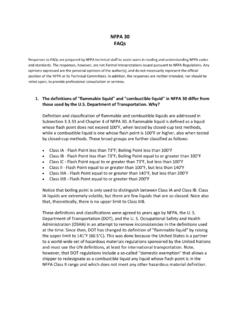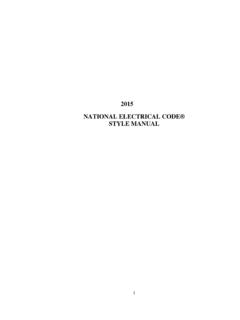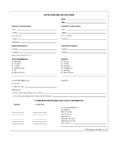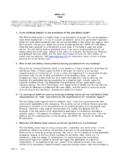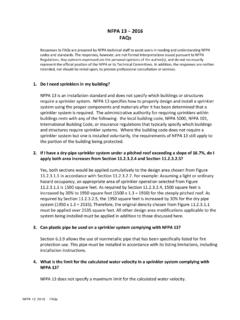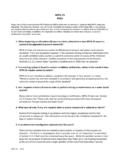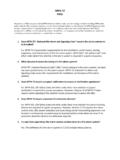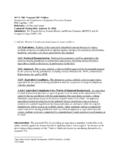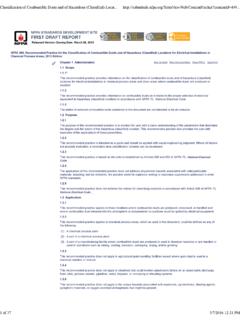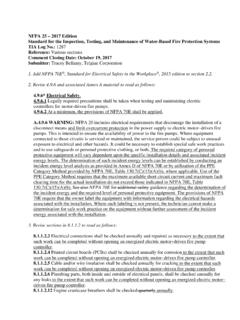Transcription of NFPA 70E® 2012 20 Most Frequently Asked Questions
1 Copyright 2013 National Fire Protection Association . All rights reserved. May 2013 nfpa 70E 2012 20 most Frequently Asked Questions By Michael Fontaine 2 Ask an nfpa Expert The Technical Questions Service is free with your nfpa Membership. Our Technical Questions Service provides a convenient way to receive timely and consistent technical assistance when you need to know more about nfpa codes and standards relevant to your work. Responses are provided by nfpa staff. Call or log-in to nfpa with your Questions and our technical staff make it their priority to get you an answer.
2 We receive hundreds of Questions each week and these are the 20 most Frequently Asked Questions and the answers on nfpa 70E . For more information on nfpa Membership go to: nfpa Members, next time you have a question, call or log-in online and get answers. 20 most Frequently Asked Questions These are the top 20 Questions that have been fielded in the past year. 1. What section of Article 130 do you consider to be the most important? I consider to be the most important because it points out that all of the requirements in Article 130 apply whether the incident energy (calculation) method or hazard/risk category (table) method are used.
3 2. Is the employer required to document electrical safety related training and for whom? In accordance with (E) the employer is required to document electrical safety training for qualified persons ( (D(1)), and for unqualified persons relative to electrical safety-related practices necessary for their safety ( (D)(2)). 3 3. What type of training documentation is required? Per (E), training documentation is to include the content of the training, each employee s name and the dates of the training. 4. When is an employer required to retrain (provide additional training for) employees regarding electrical safety-related practices?)
4 As indicated in (D)(3) an employer is required to provide additional training when: (1) supervision or the annual inspection indicates that an employee is not following the required electrical safety-related work practices; or (2) when new technology or new equipment or changes in work procedures requires the use of electrical safety-related work practices that are different from those which the employee would normally use, or (3) when an employee is required to use electrical safety-related work practices that are new to them. 5. Is there a stated mandatory time period under which retraining (additional training) is required?
5 As stated in (D) employees are to be given additional (retaining in) electrical safety-related work practices every three years. It should be noted the nfpa 70E, Standard for Electrical Safety in the Workplace is revised on a three year cycle. 4 6. In the process of performing electrical lockout/tagout (creating an electrical safe work condition) is lack of voltage verification by an adequately rated voltage detector required? Yes, see (5). However, there may be some situations where it would not be possible to perform lack of voltage verification where there is no accessible exposed point.
6 In this case, the procedure, in accordance with (F)(2)(f)(5), is to establish planning considerations that include methods of lack of voltage verification. 7. What information is required to be included on an arc flash boundary hazard warning label? Items (1) apply when an incident energy analysis is performed. Item (1)d. applies when the hazard/risk category method is used. In accordance with (C) is to include all of the following information: (1) At least one of the following a. Available incident energy in cal/cm2 and the working distance b. Minimum arc rating of clothing c.
7 Required level of PPE d. Highest hazard/risk category (HRC) for the equipment (2) Applicable nominal system voltage (3) Applicable arc flash boundary 8. Regarding arc flash warning labels are all of the items identified in (C)(1) applicable when the hazard/risk category (table) method used? When the HRC method is used the arc flash warning label is to include the highest hazard/risk category (HRC) for the equipment. Items (C)(1)a through c do not apply. They are only applicable when the incident energy (calculation) method is used. 9. Does Table (C)(15)(b) apply to an arc-in-a-box situation?
8 Table (C)(15)(b) is only applicable to open air arcs. It is not applicable to enclosed equipment arc-in-a-box situations. 5 10. What are the available methods according to nfpa 70E of performing an arc flash hazard analysis? There are two methods that the technical committee (TC) to nfpa 70E consider applicable ( , equally valid). They are the incident energy (calculation) method and the hazard/risk category (table) method. 11. Is there a preferred method (single method) of performing an arc flash hazard analysis? The technical committee (TC) to nfpa 70E considers the two methods identified in nfpa 70E of performing arc flash hazard to be equally valid.
9 12. How do I determine if my equipment situation conforms with the overcurrent protective device parameters identified in the equipment headers to Table (C)(15)(a)? Several different methods are available. All of the method involves the assumption of some risk. It is up to the employer to determine if the risk involved with the method used is acceptable. The simplest method would be to determine the interrupting rating of the main circuit breaker on the equipment or that of the upstream circuit breaker and whether the device has an instantaneous trip element or a short time trip element.
10 When the arcing current is within the instantaneous trip region of an insulated case or molded case circuit breaker, it should trip within 2 cycles ( seconds). For electrical systems rated 600 volts or less the arcing current is always less than the short circuit current. Another method to determine short circuit current would be to use a simplified calculation method. The most detailed method would involve using power system analysis software and in that case, the party doing the calculation would most likely use the incident energy method. 13. When I use the hazard/risk category (table) method, how do I determine the arc flash boundary?
